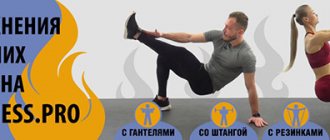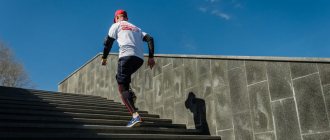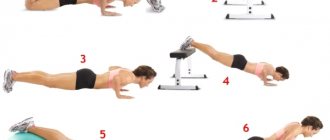Running has been popular since ancient times; even the first Olympic Games, held BC in Greece, included competitions only in this sport. And now it remains the most accessible and favorite type of physical activity among fans of a healthy lifestyle. But there is a category of athletes who stubbornly deny the benefits of running for themselves - bodybuilders. Every second athlete is sure that running and bodybuilding cannot be combined, and simultaneous practice of these two sports will only reduce the results of each of them. Let's try to dispel this misconception.
Why bodybuilders don't want to combine strength training with running
- The main goal of many non-professional runners is to train the heart muscle. It’s not for nothing that jogging is considered to be the basis for cardio exercises. However, working out in the gym with exercise machines also seriously loads the heart, which, of course, strengthens it well. Therefore, fitness classes can be considered an effective alternative to cross-country.
- Strength training increases the production of anabolic hormones , which stimulates muscle growth. On the other hand, long running after strength training leads to inhibition of this process. It is for this reason that those who engage in marathon running have a certain body composition , thanks to which their occupation becomes obvious to everyone. This means that if you want to acquire large muscles, you should discard the option of running long distances.
- And although running exercises and strength training have differences in how much energy is spent (in the first case it is more wasteful), adherents of weight training note the fact that even after completing a strength training session, the muscles continue to receive an energy charge from fat reserves, which allows them to perform faster recover and grow . So, by eating at the end of the workout, the athlete will not gain weight, but on the contrary, everything he ate will be used to restore and increase muscle material.
- Running before strength training will lead to a large depletion of energy reserves, and this will affect how well you perform in your gym sessions. If you run after weight training , then your body will immediately begin to take care of its lost energy reserves, and only then will it move on to building muscle.
Running in bodybuilding - all the myths about cardio training while gaining muscle mass
Workout
Friends, hello! Today we will talk to you about an intriguing topic, which causes a lot of discussions, arguments and even quarrels among most bodybuilders, both in the gym and on forums on the Internet. – Running in bodybuilding?! Is it important?
Has its effectiveness been proven? Here you will find all the arguments for and against, as well as useful information about the effect of running on an athlete's beautiful body.
The most interesting articles for your training:
TRAINING FOR FEMALE WEIGHT LOSS. VALUABLE TIPS FOR BEGINNING ATHLETES
LEG TRAINING – GUARANTEED PUMPING TECHNIQUES
BODYBUILDING AND MASS TRAINING WILL BRING ITS RESULTS IF YOU DO EVERYTHING RIGHT
SIMPLE EXERCISES FOR THE CHEST MUSCLES FOR GIRLS WILL HELP MAKE THE BREASTS EVEN BEAUTIFUL AND TIGHTER
DELTA EXERCISES ARE ONE OF THE MOST FAVORITE EXERCISES BY MANY BODYBUILDERS
Facts speak louder than rumors
It's no secret that running is very important for human health. It has a beneficial effect on the cardiovascular, digestive, respiratory systems, etc. But can we consider that running is a panacea for all diseases or their prevention? Let's figure it out.
Scientists from the University of Iowa have proven that running at least 7 minutes a day reduces the risk of premature death from any disease by 30%, and from cardiovascular disease by 45%.
By the way, 50,000 Americans took part in the study, which indicates the scale of the study. Additionally, scientists from the Institute of Orthopedics in Milan found that running also has a beneficial effect on strengthening human bones.
But there is no doubt that in cases where there are medical contraindications, it is better not to get carried away with jogging. Otherwise, they can not only worsen a person’s well-being, but also aggravate the existing disease process.
On the scales: gym or running
What is the most important thing in sports? Of course, have a healthy body and... a trained heart. Because the endurance and functionality of the human body depends on the work of the heart muscle. But what is better to prefer for its development and strengthening: running or iron training?
In bodybuilding, athletes must pay special attention to the work of their heart. The greater the body weight, the more blood it needs, and the more voluminous the heart muscle itself should become.
To do this, you need to perform regular cardio training while maintaining a constant average heart rate of 110-140 beats per minute. It can be:
- fast walk;
- slow steady running;
- swimming;
- boxing classes;
- iron training, etc.
No matter what you do, the main thing is to set a moderate pace and maintain a heart rate of 110-140 beats per minute for 15-60 minutes. This means that by training your body muscles in the gym or running in the stadium, you simultaneously develop the heart muscle, making it easier to work further.
But at this time the knee joints may suffer when choosing any sports activity. This is due to the lack of warm-up before training, incorrect exercise technique, inappropriate shoes, fitness clothing, and even the wrong running surface.
They create pain in the joints and make them vulnerable to injury, and subsequently lead to the development of pathology of the musculoskeletal system. Therefore, while paying attention to the heart, do not forget about other parts of your body, creating comfortable and safe conditions for sports and maintaining human health during exercise.
We run around in shorts, losing weight before our eyes
When we want to lose weight quickly and effectively, what do we do? We try to close our mouths, reduce our food intake, and run – demonstratively, beautifully, diligently. But for some reason we are not losing weight... What is the reason?
There is a table of energy consumption that can be used to calculate how much energy, that is, kcal, a person spends as a result of some activity: office work, cycling sprint, aerobics, etc. There is also a coefficient for running at a speed of 10 km/h, which is 0.1759.
Let us now calculate using a basic formula - how many kcal will a stately man weighing 90 kg spend in 30 minutes of intense running in a park or stadium:
0.1759*90*30 = 474.93 kcal
474.93 kcal! On the one hand, this is a lot, but on the other, if you consider that this is equal to 100 g of Krakow sausage, or a bar of chocolate, or 200 g of pilaf with meat, it becomes not too joyful.
But you shouldn’t be upset, because losing fat without losing muscle mass is possible if you follow some rules:
- Walk quickly or run slowly for 60 minutes or more.
- The best time for such a run is in the morning (on an empty stomach, you can drink water), evening (after eating a protein meal) or after training;
- You should also follow a diet - small meals, eat proteins and complex carbohydrates, drink enough water, and give up alcohol.
- Don't forget to get enough sleep and be in a good mood.
And only in this way will metabolic processes be activated, and subcutaneous fat will be directly burned. And let it not be as fast as you want, but it will be effective and useful.
Running in the morning is especially important - it not only guarantees a charge of vivacity, strength for the whole day and a good mood, but also saturates the body with oxygen, starts metabolism, strengthens muscles, joints, ligaments and tendons.
For those who are losing weight, it is important to know that it is absolutely forbidden to eat immediately after running. Until you start eating breakfast, your body's fat burning processes are hard at work.
Running and bodybuilding - obvious or incredible
If running for weight loss is effective, then what about bodybuilding? Does it do harm or benefit when gaining weight? Some bodybuilders believe that in order to build muscle evenly, it is necessary to alternate running with iron training.
Others, on the contrary, categorically prohibit bodybuilders from running. Let's find the right answer, which will be partly suggested by sports videos, partly by YouTube videos.
There are anaerobic and aerobic exercises. The first, thanks to growth hormones, are intended to increase explosive strength and increase muscle mass, the second - to increase the body's endurance, raise tone, and strengthen the cardiovascular system.
By the way, aerobic training triggers decay reactions - catabolism, which promotes weight loss. In our discussion topic, anaerobic exercises include strength training, aerobic exercises include running.
Given the above, running will in no way directly contribute to the growth of an athlete's muscles. It can only create favorable conditions for the development of muscle mass, that is:
- increase energy potential;
- develop endurance;
- normalize metabolism;
- improve well-being and mood;
- positively influence the general condition and support of human health, including an athlete.
But at the same time, if you run incorrectly and do not follow the recommendations of professionals, then jogging can destroy the athlete’s muscles.
How to combine running and weight training, and which program to follow is the personal choice of the bodybuilder. The main thing is that running brings true pleasure and does not become a routine activity.
And yet, it is important to take a break of several days between strength training and running so that the muscles have time to “rest” and recover.
Girls and boys are different...
And now we come to the most interesting part. Surely, every bodybuilder knows the distinctive characteristics of different body types. There are three human somatotypes:
- ectomorph;
- mesomorph;
- endomorph.
This is important for an athlete, because not only the formation of a training strategy and sports nutrition depends on the body type, but also the final result - the athlete’s figure itself. Therefore, running is not recommended for everyone, especially when a person is diligently building muscles.
An ectomorph refers to a lean body type that has a very difficult time developing muscle mass and even more difficulty maintaining it. High-intensity strength training and a minimal amount of cardio are recommended for him.
A mesomorph has a broad chest and shoulders, voluminous muscles and a minimal amount of body fat. He can be considered lucky, since he already has an athletic figure by nature. It is enough to exercise regularly, combined with running, every other day for 35-40 minutes, and a stately body is guaranteed for many years.
An endomorph has a round shape, a wide waist and bones, and a high percentage of subcutaneous fat. He is recommended to run for 40-45 minutes in order to activate metabolic processes and burn extra calories.
Most often this is interval running, accompanied by local accelerations, which is recommended after training. At this moment, subcutaneous fat becomes a source of energy and is effectively broken down.
Therefore, before you run along with the morning rays, decide what somatotype you belong to, weigh the pros and cons, and run for your health.
The truth is in the details and a reasonable approach
Taking into account the recommendations of famous bodybuilders, let's summarize who and how important running is in bodybuilding.
To grow muscle mass, professionals recommend:
- moderate jogging for 5-10 minutes as a warm-up before starting strength training in order to warm up the athlete’s muscular system;
- Jogging no more than 15 minutes a day as cardio exercise.
For drying and definition of forms, running is advisable:
- at a moderate pace for 20-30 minutes a day, taking into account a stable pulse;
- on days off from strength training.
For the purpose of losing weight, jogging is an integral part of an athlete's lifestyle on the path to an ideal figure.
Finally, I would like to say something important: running is necessary for every person who wants not only to be attractive and muscular, but also healthy. So run, friends, run – not from dogs, but for the sake of happiness.
And as usual, a video on the topic: “Myths of bodybuilding.”
If the article was educational for you, do not forget to share it with your friends in social articles. And also subscribe to our updates to be erudite in the field of sports, health and beauty.
Source: bodybuilding-free.ru
This is interesting: Local weight loss - methodological instructions for activating adipocytes, or how to dry out a fatty muscle
Why runners don't want to combine strength training with running
- Jogging brings significant benefits to the heart, as it is gentle on the human body, and the load can be easily reduced or increased based on personal feelings. At the same time, when working with dumbbells and heavy weights, it is more difficult to exercise self-control of your body. Therefore, strength training has a stronger negative effect on the heart and blood vessels. Based on this, we can say that going out only for jogging will be healthier for your cardiovascular system.
- Have you ever noticed that short distance runners are often distinguished by their athletic physique and muscles that are the envy of many athletes? This is due to the fact that short-distance running, identical to strength methods, uses precisely the muscle fibers that are most capable of growing when receiving certain loads. And if you also take into account that various muscles will be involved when running, then you will definitely get a comprehensive growth of your muscles as a final result.
- Running exercises consume a huge amount of energy and calories, more than strength training. Jogging consumes several times more calories than when working muscles in the gym. Also, after 30 minutes, the body begins to burn fat reserves as the liver and muscles begin to lose glycogen. This means that running will help you lose excess weight from your body.
- You won’t be able to go for a full run after doing a strength program, unless you can run to cool down after a workout. So many people choose between cross-country and the gym.
This is interesting
- [uaf_vkcount url='href=»https://beginogi.ru/vitaminyi-dlya-myishts-sustavov-i-svyazok-i-kakie-vitaminyi-nuzhnyi-dlya-rosta-myishts/']
Vitamins for muscles, joints and ligaments and what vitamins are needed for muscle growth
- [uaf_vkcount url=”https://beginogi.ru/zachem-nuzhnyi-rezinki-dlya-bega-pravilnoe-primenenie/”]
Why do you need elastic bands for training? Correct Application
Additional benefits of running for a bodybuilder
In addition to helping to build muscle mass, running has other beneficial effects for the athlete:
1. Running perfectly pumps up the leg muscles, including the smallest ones. Exercises in the gym, as a rule, act in isolation only on large muscles, while small fibers remain idle, which affects progress as a whole. Involving small muscles in training through running will allow you to quickly increase working weights.
2. Although strength training strengthens the cardiovascular and respiratory systems, it does not force them to work at full capacity. Cardio exercise will better train your heart and lungs, significantly increasing your endurance.
3. With the help of aerobic exercises it is easier to achieve body relief. Exercises in the gym, aimed at relief, force you to gruelingly repeat the same movements a huge number of times; in this regard, running is much easier and more exciting.
4. Running cleanses the body by flushing out toxins through sweat. As a result, metabolism returns to normal.
5. Additional access of oxygen to cells during cardio training has a positive effect on muscles and the central nervous system (CNS). A well-functioning central nervous system, in turn, promotes more coordinated muscle function, reduces the risk of injury and increases the body’s ability to heal itself.
There are many benefits to running, but there is a way to make it even more powerful. To do this, you need to create a training program individually for your body type.
Combining running and bodybuilding
In order to properly combine running and strength training, you should distribute them on different days of the week . That is, you need to choose those days when you jog and those when you lift weights.
On those days when strength training is planned, you can go for a run, but only as a warm-up, and no more than 1 km.
On jogging days, it is better to do workouts for no more than half an hour, so that fast and slow muscle fibers do not conflict with each other.
Once a week or more, if your strength allows, you can do interval jogging, which differs in its intensity.
Advice
When you are actively working on increasing your mass, the loads of the running plan should be significantly reduced, and vice versa, if the goal is to achieve relief, then you need to run more often and longer.
So, strength training in running plays an important role, however, it is not always necessary. So, to use it correctly, you need to carefully consider the training processes and correctly combine them. This approach will provide an opportunity to get benefits from both of these sports.
What are the benefits of running?
First of all, running provides aerobic exercise and “accelerates” the metabolism. Regular jogging helps improve the body's endurance and strengthen the heart and blood vessels. In addition, running:
- slows down cell aging;
- prevents the development of Alzheimer's disease;
- supports joint mobility;
- eliminates obesity;
- is the prevention of atherosclerosis.
In addition to the obvious changes in the body, running also increases stress resistance. Each run calms the nervous system, helping the genes responsible for stress turn off. In addition, the body receives additional neurochemical “trophies” in the form of endorphin (the hormone of happiness) and dopamine (the hormone of pleasure).
A light jog is recommended even for overweight people , because just 20 minutes of physical activity can burn about 300 kcal.
Important! Fat is burned not only during running, but also for several hours after . Therefore, running is especially recommended for people who are losing weight.
Video. Is it possible to run after strength training?
Does cardio training interfere with muscle gain? How to gain muscle without fat
How I combine running and strength training.
Is it possible to run after strength training?
- >
Does cardio training interfere with muscle gain? How to gain muscle without fat
Cardio training while gaining muscle mass will help speed up your metabolism (metabolism), which helps you recover faster from iron workouts and improves your digestive system. Cardio training while building muscle will help you gain lean muscle mass, minimize body fat, and allow you to eat more calories due to your increased metabolism.
- >
How I combine running and strength training.
I ran for three years. Then I wanted to add a little more torso muscle. So I started going to the gym. At first I thought that I would run significantly less. But it didn't work out. I really wanted to run. Continued running. At first my legs were very sore. Because I did heavy basic exercises with a barbell. Then I removed the deadlift, reduced the squats and everything fell into place. I started running on days off from the gym. It turns out three strength and three running workouts.
- >
Strength and cardio training on a diet[edit | edit code]
Results of a 2014 meta-analysis by a group of scientists: Eric Helms (ER Helms), Peter Fitscher (Fitschen PJ), Alan Aragon (AA Aragon), John Cronin (Cronin J) and Brad Schoenfeld (BJ). One meta-analysis is about nutrition[1], the second is about training[2].
Briefly about dietary recommendations[3] from the first meta-analysis
- Protein 2.3-3.1 g/kg LBM [4]
- Fats 15-30% of calorie deficit [5][6]
- Carbohydrates according to dietary preference/plan or diet type
- Weekly fat loss (% of body weight) 0.5-1% [7][8]
To achieve the effect of maximizing the preservation of muscle mass on a diet, it is recommended to follow a number of rules.
- Strength training and its anabolic effects can help minimize muscle loss during competition preparation.
- It is more correct to build a training cycle according to the principles of block and wave periodization.
- It is recommended to train each muscle group at least 2 times a week or more often. If each muscle group is trained more than 2 times a week, then it is recommended to distribute the training volume in such a way as to avoid excessive load within one workout (in general, if we train more often, it is better to reduce the volume and distribute it more evenly across all days of the training week).
Below is the recommended training frequency for each muscle group according to Wernbom at al.[9], but I want to make it clear that Wernbom wasn't looking at the issue in terms of caloric deficits, he was looking at protocols for hypertrophy under normal nutritional conditions (well, at least this is not stated separately, but in essence it is logical and presumed), and yes, this data was collected on athletes of different levels of training (from beginners to professional athletes; more than 60 studies), on the type of training, intensity, level of training. Some of this data, among other things, formed the basis for the conclusions of Helms’ team.
- The number of repetitions can vary from low to high (3-15), but should generally be in the range of 6 to 12 repetitions with a weight of 70-80% of 1RM (one repetition maximum).
- For one workout, each muscle group should have a total of about 40-70 repetitions, although experienced athletes can use higher volumes.
- Rest intervals should be the standard 1-3 minutes, although the rest period can be longer.
- The pace of the exercise should be selected in such a way that throughout the entire training movement maximum control is maintained and technique is observed as much as possible: in this case, the concentric phase (lifting weights, muscle contraction) should take about 1-2 seconds, the eccentric (lowering) phase should take about 2 -3 sec.
- Recommendations for failure training: You should limit training to failure when performing multi-joint exercises, but you can use this approach for high-repetition, single-joint exercises.
- The basis of the training should be multi-joint exercises, and also include isolating single-joint exercises as “auxiliary exercises” to load those muscles to which the athlete pays special attention. Moreover, it is recommended to perform multi-joint exercises before single-joint exercises. And it is advisable to train large muscle groups at the beginning, moving on to small ones. But at the same time, one should be guided by the athlete’s goals, and if there are lagging muscle groups, it may make sense to start training by working the lagging muscles (the logic here is simple, if you start working these muscles after performing a series of exercises, then there may not be enough strength left for the lagging ones and their development will be ineffective, which ultimately can lead to even greater loss on the diet).
- The full amplitude of the training movement in ideal technique (or close to it) is recommended.
- Cardio training can be used to optimize the fat burning process. But it is necessary to take into account that increasing the frequency and duration of cardio training negatively affects the results of strength training. Thus, it is recommended not to overdo it with cardio training; you should maintain the frequency and duration of cardio training at the minimum required (for fat burning) level. Based on research, it is optimal to perform cardio on stationary bikes or cardio workouts that involve the whole body (not just the upper or lower body; for example, fullbody with light weights/kettlebells).
High-intensity cardio is not bad if present, but here you need to look at individual characteristics in recovery, i.e. It should be taken into account that this type of cardio requires more recovery time. Fasted cardio does not seem to have any advantage over postprandial exercise and may even have a negative effect, but there is no definitive data on this (fasted cardio, although associated with nitrogen losses, equates to about 14 grams of amino acids per day). 60 min cardio, but there is no data on whether this is a loss of MM, and whether this loss will ultimately be compensated by the intake of protein in the post-workout meal).











